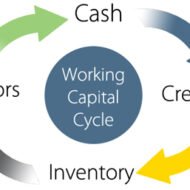Posted by Managementguru in How To, Human Resource, Motivation, Strategy
on Feb 9th, 2016 | 0 comments

Employee recognition is an increasingly important management requirement in the workplace, with a number of research studies showing the importance of staff engagement and appreciating employees for their daily positive contributions to the team. “To win in the marketplace you must first win in the workplace.” – Doug Conant, CEO of Campbell’s Soup Appreciation and Recognition are the two major factors that bring about employee job satisfaction and happiness. According to the equity theory, based on the work of J. Stacy Adams, workers compare the reward potential to the effort they must expend. Equity exists when workers perceive that rewards equal efforts. “When people are financially invested, they want a return. When people are emotionally invested, they want to contribute.” – Simon Sinek But employees just don’t look at their potential rewards, they look at the rewards of others as well. Inequities occur when people feel that their rewards are inferior to the rewards offered to other persons sharing the same workloads. “Employees who believe that management is concerned about them as a whole person – not just an employee – are more productive, more satisfied, more fulfilled. Satisfied employees mean satisfied customers, which leads to profitability.” –Anne M. Mulcahy Fine! Let’s see some amazing statistics that clearly shows “What are and what aren’t making employees happy?” Unhappy Employees’ Stats 88% of employees don’t have passion for their work. 75% of workers don’t quit their job, but quit their boss. 78% of people would work harder in their jobs if they were recognised. 60% of those who don’t feel they are appreciated are looking for a job. 65% of working Americans say they receive no praise or recognition on the job. Employee turnover was up by 46% in companies with ineffective employee recognition programs. Did you know the 1 reason most American employees quit their jobs is they don’t feel appreciated? What makes employees motivated Happy Employees’ Stats Organizations where recognition occurs have 14% better employee engagement, productivity and customer service than those without. 90% find a “fun” work environment extremely motivating. 76% said opportunities for growth were the top reason they stayed in an organization. 70% of workers are motivated by non-monetary rewards at work. 80% of those who feel they are being appreciated stay put. The equity theory makes a good point: What a manager thinks is irrelevant to an employee because the real issue is the way an employee perceives his or her situation. Rewards perceived as equitable should have positive results on job satisfaction and performance; those rewards perceived as inequitable may create job dissatisfaction and cause performance problems. Every manager needs to make sure that any undesirable consequences from equity comparisons are avoided, or at least minimized, when rewards are allocated. To motivate workers, managers must strengthen workers’ perceptions of their efforts as both possible and worthwhile, clarify expectations of performances, tie rewards to performances, and make sure that rewards are desirable. Employee Recognition and Appreciation So Some Hard Hitting Facts Strategic recognition drives engagement Lack of recognition drives turnover High employee engagement leads to better business results or ROI Awards, recognition and praise might be the single most cost effective way to maintain a happy productive force. Respect employees, ask for their opinion and show genuine...

Posted by Managementguru in Business Management, Decision Making, Entrepreneurship, Human Resource, Motivation, Quotes and Quotes Only
on Sep 25th, 2014 | 0 comments

Best Leadership Quotes “Only one man in a thousand is a leader of men — the other 999 follow women. Groucho Marx The Leader In You – #Dale Carnegie “Leadership is the capacity to translate vision into reality. – Warren Bennis Developing the Leader Within You – “You don’t lead by pointing and telling people some place to go. You lead by going to that place and making a case. – Ken Kesey Awaken the Leader in You – Mitesh Khatri “No man will make a great leader who wants to do it all himself, or to get all the credit for doing it.– Andrew Carnegie How To Win Friends Influence People – “Outstanding leaders go out of their way to boost the self-esteem of their personnel. If people believe in themselves, it’s amazing what they can accomplish. – Sam Walton The Leader in You – Peter Miller “To lead people, walk behind them.” – Lao Tzu “The best leader is the one who has sense enough to pick good men to do what he wants done, and the self-restraint to keep from meddling with them while they do it – Theodore Roosevelt “The challenge of leadership is to be strong, but not rude; be kind, but not weak; be bold, but not bully; be thoughtful, but not lazy; be humble, but not timid; be proud, but not arrogant; have humor, but without folly– Jim Rohn “Leadership is a potent combination of #strategy and character. But if you must be without one, be without the strategy – Norman Schwarzkopf “Successful leaders see the opportunities in every difficulty rather than the difficulty in every opportunity – Reed Markham “The problem with being a leader is that you’re never sure if you’re being followed or chased – Claire A. Murray “Do not follow where the path may lead. Go instead where there is no path and leave a trail – Harold R. McAlindon “Learn to see things backwards, inside out, and upside down – John Heider, Tao of Leadership “The real leader has no need to lead- he is content to point the way. #Henry Miller “A leader is a dealer in hope – Napoleon Bonaparte From Manager to Leader “If your actions inspire others to dream more, learn more, do more and become more, you are a leader – John Quincy Adams “The art of leadership is saying no, not yes. It is very easy to say yes – #Tony Blair “Never tell people how to do things. Tell them what to do and they will surprise you with their ingenuity – George Patton “Leadership does not always wear the harness of compromise – Woodrow Wilson “Take time to deliberate; but when the time for action arrives, stop thinking and go in – Andrew Jackson “To be a great leader and so always master of the situation, one must of necessity have been a great thinker in action. An eagle was never yet hatched from a goose’s egg – James Thomas “A good general not only sees the way to victory; he also knows when victory is impossible – Polybius “Leadership is being the first egg in the omelet – Jarod Kintz “Leadership consists of nothing but taking responsibility for everything that goes wrong and giving your subordinates credit for everything that goes well – Dwight D. Eisenhower “##management is doing things right; leadership is doing the right things – Peter F. Drucker...

Posted by Managementguru in Entrepreneurship, Financial Management, Project Management, Startups, Strategy
on Aug 4th, 2014 | 0 comments

Top 8 Mistakes That Kill #Startups Let us look at some mistakes that kill startups News: About three-quarters of venture-backed startup firms in the U.S. don’t return investors’ capital, according to recent research by Shikhar Ghosh, a senior lecturer at Harvard Business School. This information made me think and I have tried to summarize the main reasons for flawed-startups below in order to caution the young and growing entrepreneurs. 1. An Unscalable Idea Understand that a Technology-driven idea with more mass appeal is what potential investors are looking for. If your business is not easily scalable across a wide market, higher margins cannot be reaped for the kind of money invested. It is always better that your product or service is appealing to all types of clients in the market. 2. #Lack of Competitive Research Don’t bother if the business idea you are about to launch already exists in the market; let yours be unique and new. Think different is what I would suggest. WhatsApp is one great example for unique contribution to the android market, don’t you think so? Make sure you are clearly differentiated from the others (e.g., better product, better value, different target client) and that your plan is SECURE against future market entrants who may try to imitate you after your initial success. 3. #No Focus ‘One thing at a time’ will be the mantra for startups where entrepreneurs have to concentrate on launching a single product at any given time. This will also help in giving clarity to those who work under you. Don’t try to be a jack-of-all-trades, but end up being a master-of-none without a laser-sharp focus to start. 4. Catch Hold of Investors even at an Early Stage: First try to send feelers to whom you think as potential investors through the right channels. Say, you are a builder and trying to launch your first project. How will you make money rolling in to keep your project going? Either you go for bank loans – no bank will offer you big loans without proper recommendation, fund-flow projection and collaterals or you need to pitch-in this idea to known circles to popularize your product and raise seed money by way of advance. What I’m trying to highlight is that you need to bring in some initial investment which will help to keep the wheels rolling. 5. No Passion or Persistence Your passion should be infectious enough to attract the right kind of investors. Not all are lucky like Matteo Achilli, the 20 year Italian student, who is about to launch a new social networking site in the lines of LinkedIn, called ‘EGOMNIA”. ARVE Error: Mode: lazyload not available (ARVE Pro not active?), switching to normal mode Tech giants like Microsoft and Google have already geared up themselves to support this lad in areas of marketing and cloud computing. We should appreciate Matteo for his passion to create a networking site where job seeking professionals will be ranked and then directly connected to the employers. His persistence has paid off and he has been termed as “Italy’s Mark Zuckerberg”. 6. Failing to Form a Well-Oiled Team: Let your team be like-minded persons with same objectives and working for a cause. Investors never will want to back-up a single individual, but a well-oiled team. Be courageous to put forward your ideas in an authentic manner. After all it is your own brain-child. If you don’t believe in it, who is going to? 7. Not Going for the Right Mentors: Be surrounded by people who have already tested and tasted success in the market. Experience is like a seasoned teacher having solutions for all your questions....

Posted by Managementguru in Accounting, Business Management, Financial Accounting
on Jul 2nd, 2014 | 0 comments

Understanding Working Capital: It is the life blood of business. Funds needed for the purchase of raw materials, payment of wages and other day-to-day expenses are known as working capital. It is part of the firm’s capital, which is being used for financing short-term operations. Hence, it may also be termed as Circulating Capital or Short-Term capital. “Working capital means current assets” –Mead, Malott and Field. “Any acquisition of funds which the current asset increases working capital, for, they are one and the same.” – J.S.mill Financial troubles and issues arise only when this entity called ‘working capital’ is not properly managed. Every successful company will hire a financial manager to deal with issues relating to finance while the CEO can look into matters relating to promotion of the product or service and the position of the company in the market. The ‘Sales Turnover or Sales Volume’ is the key issue you have to look into to gauge whether you have sufficient working capital to manage that big a volume for that particular period. You have to rotate your funds wisely keeping in mind the credit policies your company offers and the credits you may enjoy with your supplier, bank interest for the short-term loans etc. Concept of WC: Working capital implies excess of current assets over current liabilities. Funds invested in current assets is known as “Gross Working Capital.” The difference between current assets and current liabilities is known as “Net Working Capital.” What are the two types? Permanent or fixed: It is the minimum amount of current assets required for conducting the business operation. This capital will remain permanent in current assets and should be financed out of long-term funds. The amount varies from year to year, depending upon the growth of a company. Temporary or Variable: It is the amount of additional current assets required for a short period. It is needed to meet the seasonal demands at different times during a year. The capital can be temporary and should be financed out of short-term funds. The working capital starts decreasing when the peak season is over. Various Factors Influencing WC: Nature of business: Service oriented concerns like electricity; water supplies need limited working capital while a manufacturing concern requires sufficient working capital, since they have to maintain stock and debtors. Credit Policies: A company which allows credit to its customers shall need more amount while a company enjoying credit facilities from its suppliers will need lower amount of working capital. Manufacturing Process: Conversion of raw materials into finished goods is called manufacturing or production. Longer the process, higher the requirement of working capital. Rapidity of turnover: High rate of turnover requires low amount and lower and slow moving stocks need a larger amount of working capital. Say, jewelry shops have to maintain different types of designs calling for high working capital. Fast moving goods like grocery requires low working capital. Business cycle: Changes in economy has a say over the requirement of working capital. When a business is prosperous, it requires huge amount of capital; also during depression huge amount is needed for unsold stock and uncollected debts. Seasonal variation: Industries which are manufacturing and selling goods seasonally require large amount of working capital. Fluctuation of supply: Firms have to maintain large reserves of raw material in stores, to avoid uninterrupted production which needs large amount of working capital. Dividend policy: If a conservative dividend policy is followed by the management, the need for working capital can be met with the retained earnings, it consequently drains off large amounts from working capital pool. ...








